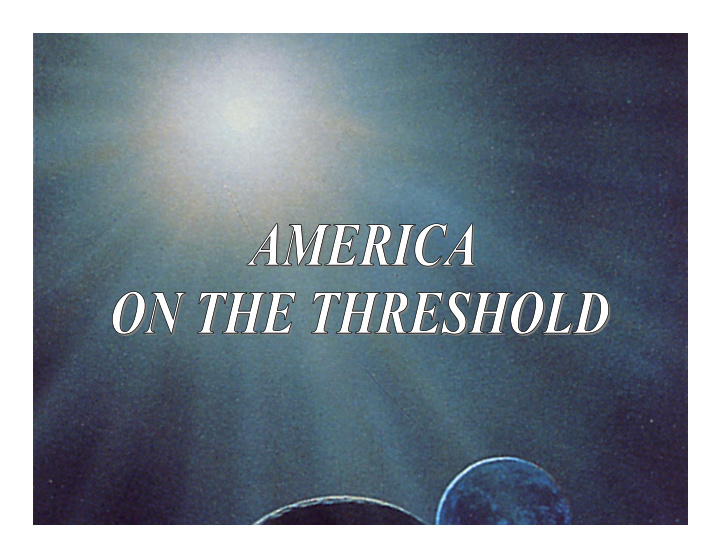



ARCHITECTURES I. Mars Exploration II. Science Emphasis for the Moon and Mars III. The Moon to Stay and Mars Exploration IV. Space Resource Utilization
RECOMMENDATIONS 1. Long range strategic plan 2. National Program Office 3. NASA Associate Administrator as Program Director 4. Aggressive acquisition strategy for SEI 5. SEI requirements incorporated into Heavy Lift Program 6. Nuclear thermal rocket technology development 7. Space nuclear power technology based on SEI requirements 8. Focused life sciences experiments 9. Education as principal theme of SEI 10. Continue and expand outreach program
Recommendation 1 Establish within NASA a long-range strategic plan for the nation’s civil space program with the Space Exploration Initiative as its centerpiece.
Recommendation 2 Establish a National Program Office by Executive Order.
Recommendation 3 Appoint NASA’s Associate Administrator for Exploration as the Program Officer for the National Program Office.
Recommendation 4 Establish a new, aggressive Acquisition Strategy for the Space Exploration Initiative.
Recommendation 5 Incorporate Space Exploration Initiative requirements into the joint NASA-DOD Heavy Lift Program.
Recommendation 6 Initiate a nuclear, thermal rocket technology development program.
Recommendation 7 Initiate a space nuclear power technology development program based on Space Exploration Initiative requirements.
Recommendation 8 Conduct focused, life sciences experiments.
Recommendation 9 Establish education as a principal theme of the Space Exploration Initiative.
Recommendation 10 Continue and expand the Outreach Program.
SUPPORTING TECHNOLOGIES 1. Heavy lift launch with a minimum capability of 150 metric tons with designed growth to 250 metric tons 2. Nuclear thermal propulsion 3. Nuclear electric surface power to megawatt levels 4. Extravehicular activity suit 5. Cryogenic transfer and long term storage 6. Automated rendezvous and docking of large masses. 7. Zero gravity countermeasures.
SUPPORTING TECHNOLOGIES 8. Radiation effects and shielding 9. Telerobotics 10. Closed loop life support systems 11. Human factors for long-duration space missions 12. Lightweight structural materials and fabrication 13. Nuclear electric propulsion for follow-on-cargo missions 14. In situ resource evaluation and processing
SPACE EXPERIENCE LEGACIES Guidelines and Pitfalls
Guidelines Establish crew safety as the number one priority Have clean lines of management authority and responsibility for all elements of the program. Ensure that one organization or prime contractor is clearly in charge.
Guidelines Establish realistic program milestones that provide clear entry and exit criteria for the decision process And create useful capabilities at each step. Ensure that the Administration and the Congress clearly understand the technical and programmatic risks and realistic costs of the Space Exploration Initiative. .
Guidelines Mandate simple interfaces between subsystems and modules. Make maximum use of modularity over the life of the program to maintain flexibility. Successive missions should build on the capabilities established by prior ones. Provide the capability to incorporate new technology as required.
Guidelines Press the state-of-the-art in technology when required – and/or when technological opportunities are promising -- with acceptable risk. Ensure optimum use of man-in-the-loop. Don’t burden man if a machine can do it as well or better, and vice versa.
Guidelines Limit development times to no more than ten years. If it takes longer, the cost goes up and commitment goes down. Focus technology development toward programmatic needs.
Guidelines Minimize or eliminate on-orbit assembly requiring extravehicular activity. Minimize mass to low Earth orbit to reduce cost.
Guidelines Have redundant primary and separate backup systems. Design in redundancy versus heavy reliance on onboard/on-site maintenance. Hire good people, then trust them.
Pitfalls Establishing requirements that you will be sorry for; i.e., wish lists being treated as requirements and allowing requirements to creep. Trying to achieve a constituency by promising too much to too many … and “low balling” the technical and financial risks.
Pitfalls Committing to interminable studies and technology demonstrations without a firm commitment to execute a real program. Not establishing configuration controls/baselines as soon as possible; e.g., weight and electrical power requirements.
Pitfalls Allowing software to run unchecked and become a program constraint rather than a supporting element. Setting up agreements for development of program elements that are not under direct program management control.
Pitfalls Not saying “We were wrong” when we were wrong.
Recommend
More recommend